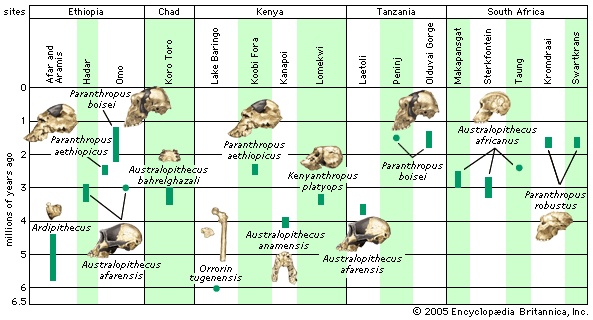archaeological timescale
also called archaeological chronology
 chronology that describes a period of human or protohuman prehistory. Some archaeological timescales are based on relative dating techniques, such as stratigraphy, which illuminate a sequence of change. Others are based on chronometric (absolute) methods such as carbon-14 dating and dendrochronology that derive a specific date from a specific item or sample (as of carbon). Most also include geographic information, as change generally varies over space as well as time. The scales of time and space considered vary depending upon the purpose of the archaeological chronology: a timescale describing the development of a locale from prehistoric campsite to medieval village to modern town might be measured in centuries and spatially restricted to a few acres or hectares, while one describing human evolution would be measured in millennia and would consider space at the level of the ecosystem or continent.
chronology that describes a period of human or protohuman prehistory. Some archaeological timescales are based on relative dating techniques, such as stratigraphy, which illuminate a sequence of change. Others are based on chronometric (absolute) methods such as carbon-14 dating and dendrochronology that derive a specific date from a specific item or sample (as of carbon). Most also include geographic information, as change generally varies over space as well as time. The scales of time and space considered vary depending upon the purpose of the archaeological chronology: a timescale describing the development of a locale from prehistoric campsite to medieval village to modern town might be measured in centuries and spatially restricted to a few acres or hectares, while one describing human evolution would be measured in millennia and would consider space at the level of the ecosystem or continent.The first archaeological timescale was developed by the Danish archaeologist C.J. Thomsen (Thomsen, Christian Jürgensen) (1788–1865), who created the relative scale comprising the Stone Age, Bronze Age, and Iron Age. The Stone Age has since been refined into more complex divisions comprising the Paleolithic Period (“Old Stone Age”), Mesolithic Period (“Middle Stone Age”), and Neolithic Period (“New Stone Age”), as well as a plethora of regional phases within these divisions.
- Francis Edgar; and Stanley Stanley, Freelan O.
- Francis Edward and Alexander Stanley Elmore
- Francis Edward Clark
- Francis Ferdinand, archduke of Austria-Este
- Francis Ford Coppola
- Francis Fukuyama
- Francis Garnier
- Francis Gary Powers
- Francis Godwin
- Francis Harry Compton Crick
- Francis Hauksbee, The Elder
- Francis Hauksbee, The Younger
- Francis Henry Underwood
- Francis Hopkinson
- Francis Hutcheson
- Francis (I)
- Francis I
- Francis II
- Francis, James Bicheno
- Francis James Gillen
- Francis Jammes
- Francis J Child
- Francis Jeffrey Jeffrey, Lord
- Francis Jeffrey, Lord Jeffrey
- Francis John McConnell